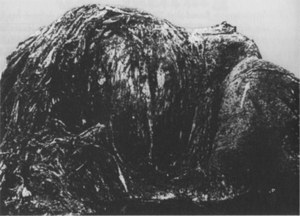New Zealand Globster facts for kids
A strange, unidentified whale carcass washed up on Muriwai Beach in New Zealand in March 1965. Muriwai Beach is about 42 kilometres from Auckland. Because it was so decayed, people couldn't tell what it was at first. It was later called a "globster". This name came from another mysterious sea creature, the Tasmanian Globster, found in Australia a few years earlier. A globster is usually a large, unidentifiable sea creature that washes ashore.
The Mysterious Beach Find
The Auckland Star newspaper reported this strange discovery on March 23, 1965. At that time, the carcass was about 20 ft (6.1 m) long. It had a tough outer skin, about 1/4 inch thick. Underneath this skin was a thin layer that looked like fat, then solid meat. The entire thing seemed to be covered in "sand-matted grey hair" that was four to six inches long.
A Marine Department officer had seen the carcass more than a week before. He said it was then about 30 ft (9.1 m) long and 8 ft (2.4 m) wide. The strange creature was found about 15 miles from the southern end of Muriwai Beach. The newspaper article even showed two photos of it.
When shown the pictures, John Morton, who led the zoology department at the University of Auckland, was puzzled. He said, "You can rule out whales because of the hair." He also ruled out sea elephants and sea cows because of its large size. He couldn't think of anything it looked like. People had many ideas about what it could be. Some thought it was a "sea monster," while others suggested it was an unusual elephant that had died at sea.
Solving the Mystery
The very next day, March 24, 1965, the Auckland Star shared an update. Scientists from Auckland University had done tests on parts of the "hairy" mass. They identified it as the "very decomposed" remains of a whale.
Senior students from the zoology department had visited the carcass the night before. They took a large piece of it for testing. Miss J. Robb, a senior zoology lecturer, explained the findings. She said the skin and most of the blubber (whale fat) had been scraped off or eaten away. This left behind a fibrous tissue. This tissue was so evenly shredded that it looked just like hair.
"We are positive of our identification," Miss Robb stated. "It is a very dead, very smelly whale." Neither of the Auckland Star articles used the word "globster" to describe the find.


